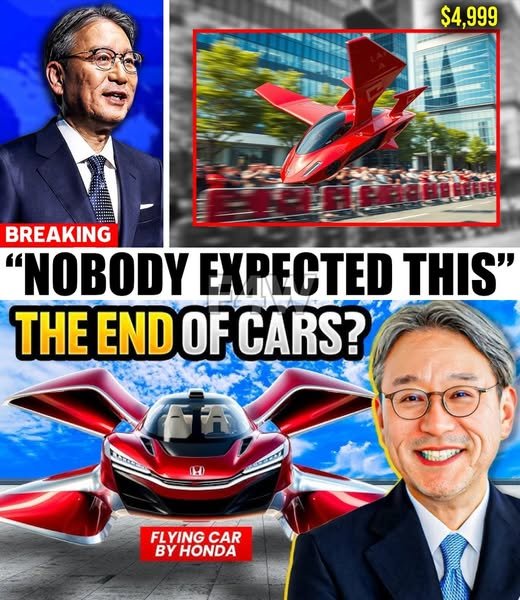In a stunning announcement that has electrified the world of transportation, Honda’s CEO, Toshihiro M, unveiled the Aspire—the world’s first flying car priced at an astonishingly low $4,999. This bold move promises to revolutionize personal travel by making flying cars accessible to the masses, not just the ultra-wealthy. But while the Aspire’s sleek design, hybrid powertrain, and affordable price tag sound like the future of mobility, many experts and consumers remain skeptical. Is this truly a breakthrough that will change the way we move, or is it an overambitious dream fraught with practical and safety challenges?
Democratizing the Sky: A New Era of Personal Travel?
For decades, flying cars have been the stuff of science fiction, often portrayed as luxury vehicles for the rich and famous. Honda’s Aspire challenges this notion head-on by offering a flying car at a price point that most people can realistically afford. At $4,999, the Aspire shatters the stereotype that personal air travel is an exclusive privilege. This democratization of flying could redefine urban mobility, reduce traffic congestion, and open new possibilities for commuting and travel.
Honda’s reputation for reliability and innovation lends credibility to the Aspire. The company’s expertise in automotive engineering combined with advanced aircraft technology has produced a vehicle capable of seamlessly transitioning from road to sky. Its aerodynamic design ensures stability and efficiency, while the hybrid system—combining electric motors with a small gas turbine engine—promises impressive performance and eco-friendliness. With a flight range of up to 250 miles on a single charge, the Aspire could replace many traditional car trips, reducing carbon emissions and dependency on fossil fuels.
The Skeptics’ Perspective: Too Good to Be True?
Despite the excitement, many industry experts and safety regulators are raising red flags. The idea of a flying car priced under $5,000 seems almost too good to be true. Manufacturing costs for such advanced technology—including lightweight materials, hybrid engines, and sophisticated flight controls—are typically astronomical. How can Honda deliver such a complex vehicle at a fraction of the cost of existing drones or small aircraft?
Safety is another major concern. Flying cars introduce new risks that go beyond traditional driving hazards. Air traffic control, pilot training, emergency procedures, and collision avoidance in three-dimensional space are complex challenges that have yet to be fully addressed. Can an affordable flying car ensure the safety of its users and people on the ground? Critics argue that widespread adoption without rigorous regulation and infrastructure could lead to chaos or accidents.
Environmental and Infrastructure Challenges
While the Aspire’s hybrid system is eco-friendly compared to gasoline-only vehicles, the environmental impact of mass flying car adoption is uncertain. The energy demands of vertical takeoff and landing, battery production, and maintenance could offset some of the green benefits. Additionally, the infrastructure needed to support flying cars—such as landing pads, charging stations, and air traffic management systems—is largely nonexistent today.
Urban planners and governments face difficult questions. How will cities adapt to a future where thousands of flying cars share the skies? Will noise pollution and airspace congestion become new problems? Without comprehensive planning and regulation, the promise of flying cars could quickly turn into a public nuisance.
Economic and Social Implications
The Aspire’s low price could disrupt the automotive and aviation industries, threatening jobs and business models. Traditional car manufacturers, airlines, and public transit systems may struggle to compete with this new mode of transport. On the other hand, the flying car market could create new industries and employment opportunities in manufacturing, maintenance, and air traffic management.
Socially, the Aspire could widen the gap between those who can afford personal flying vehicles and those who cannot, especially if infrastructure development lags behind. While the price is low, additional costs such as pilot training, insurance, and maintenance may still be prohibitive for many.
Conclusion: A Revolutionary Leap or Premature Hype?
Honda’s Aspire flying car is undeniably one of the most exciting and controversial innovations in recent memory. Its promise to make flying cars affordable and practical for everyday people challenges long-held assumptions about personal transportation. Yet, the road—or rather, the sky—ahead is filled with technical, regulatory, and societal hurdles.
Is the Aspire the dawn of a new era where the skies belong to all, or is it an overambitious project that underestimates the complexities of flying cars? Only time will tell. What is certain is that Honda’s bold announcement has sparked a global conversation about the future of mobility, innovation, and what it truly means to take to the skies.



